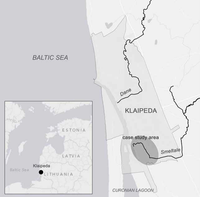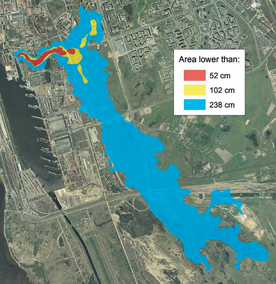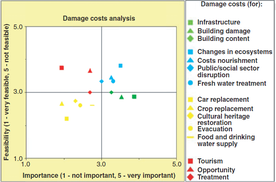Complex embankment and dyke systems in the Smeltalė River, Klaipėda city

Klaipėda is a coastal city with almost all of its territory located on coastal lowland, and the Smeltalė river situated in the Southern part of the city, falling into the Curonian Lagoon within the city area. Regular floodings of the southern city areas due to flash floods in the Smeltalė River and Baltic Sea level fluctuations are the main problem of the Klaipėda city case study area.
In addition to natural occurring flood events, climate change contributes to an increase in the likelihood and adverse impacts of flood events. Based on the assessment of climate change impacts local community adaptation actions were initiated in the Smeltalė River basin by the stakeholders, scientists, and the local interest groups.
Case Study Description
Challenges
Klaipėda is a coastal city. Almost all of its territory is located on coastal lowland, which is why areas of Klaipėda city are vulnerable to flooding. The Smeltalė River is situated in the Southern part of Klaipėda city, and has a catchment area of 124.1 square kilometres. The Smeltalė flows into the Klaipėda Strait, which connects the Baltic Sea and the Curonian Lagoon. The shores of the Smeltalė River are not reinforced, so the area near the river is not protected from flooding. The lower reaches of the Smeltalė River are situated in the lowland where the land surface is almost flat. Consequently, the floodplain of the Smeltalė River is wide. The lower reaches of the Smeltalė River, situated in Klaipėda city, are highly urbanized, with impervious surfaces covering a considerable area. The natural flow paths are replaced by the rain drainage system. Consequently, the flash flood peak discharge is much larger than that in natural conditions.
The flooding of surrounding areas (water can reach the built-up areas) is one of the most important problems associated with high water levels and flash floods by the Smeltalė River. The water level rise in the Baltic Sea will affect the water level regime in the Smeltalė River’s lower reaches. It is likely that the extreme water levels will also be affected by sea level rise. Extreme water levels in the Baltic Sea near Klaipėda are related to storm surges. The change in the intensity and frequency of heavy rain, flash floods and sea level rise can also affect the area of flooded territory and the frequency of flooding. The change in the flash-flood regime may also change the sediment regime of the Smeltalė River and the pollution from the rain drainage system.
During the initial stage of the adaptation process, analysis of climatic parameters and sea-level change was carried out and projections for the twenty-first century were prepared. Climate projections were used as the background for hydrological modelling which has been carried out, and possible future changes in the hydrological regime were determined. All modelling results indicate a sea-level rise of between 25 and 86 cm (mean value of the whole forecast: 52 cm) in Klaipėda in the twenty-first century. Recurrence of heavy precipitation in Klaipėda will also increase by up to 30%. The hydrological modelling results of potential changes in the Smeltalė river flow regime in the twenty-first century show that the risk of flooding for nearby residents will increase in the future due to the sea-level rise and heavy rain. A rise in flooding magnitude and frequency is very likely. The area of flooding will increase.
Objectives
The main goal of the project is to assess the effect of climate change on the extent and scale of the problems in the future for the Smeltalė River hydrologic regime and initiate local adaptation action. Moreover adaptation to climate change impacts was focused on the involvement of local stakeholders into the decision-making process and actions in the Smeltalė River basin.
Adaptation Options Implemented In This Case
Solutions
In order to identify the suitable adaptation measures two scenario workshops were held with the Klaipėda city municipality administration and various stakeholders. At the first workshop the projections of sea level rise and flash flood peak flow changes were presented and possible adaptation measures were identified together with the stakeholders. This was followed by a feasibility study on the costs and the efficiency of 4 adaptation measures proposed by the stakeholders and two additional measures, proposed by the authors of the feasibility study (Vilniaus Hidroprojektas Ltd., 2010). The stakeholders have decided that the most suitable measure for the Smeltalė River lower reaches will be complex embankment and dyke systems on both watersides of the river. This measure was considered the most expensive, but also the most suitable adaptation measure concerning efficiency, implementation costs and long-term durability (due to climate change impacts). Moreover, embankments should be incorporated in the recreation area which will be established in the area.
Based on the decisions from the workshops, the Klaipėda city municipality initiated the preparation of the implementation of the adaptation measures in the Smeltalė River lower reaches, ‘The Smeltalė River park’ project. The recreation area of the Smeltalė River Park will be developed on the river embankments. The dykes proposed in the Smeltalė River park plan should protect flood-prone areas. The project will be implemented in several stages. First of all, the dykes and walking paths will be constructed. After that the rest of the infrastructure will be implemented due to Klaipėda city detailed plan requirements.
Relevance
Case developed and implemented and partially funded as a Climate Change Adaptation measure.
Additional Details
Stakeholder Participation
Stakeholder participation was a key aspect in this case study, due to the fact that stakeholders were integrated in all stages of the case study, starting with the identification of the problem and of possible adaptation measures as well as the evaluation process and the final decision-making of best adaptation measures. Cost-Benefit Analysis (CBA) assessing the economical parameters and Multiple-Criteria Decision Analysis involving social, ecological, aesthetical and other measuring criteria were used as supporting decision tools, during the different workshop. Stakeholders that participated in the process included: Klaipeda water company, schools, universities, local newspaper, harbour, Regional EPD, NGOs, community members, private companies, different departments of Klaipėda city municipality (Environmental, Landscape architecture, Civil protection, Projects), City council members.
Success and Limiting Factors
Main success factors include:
- The case study is a good example where cooperation of various stakeholders was key for a comprehensive approach and a commonly accepted solution;
- The engagement of various stakeholder during the various phases of the project and decision-making process; The Cost-Benefit Analysis (CBA) and Multiple-Criteria Decision Analysis (MCDA) were helpful tools in this process;
- Technical project of adaptation measures have been initiated by the Klaipėda city municipality, being realized in a first stage of the Smeltalė River Park;
- Including climate change adaptation measures into existing development plans of local municipalities (Klaipėda city development plan).
Costs and Benefits
The preliminary costs of dyke system on both watersides of the Smeltalė river is about 5 million Euros (including river bed canalization works, but without land taxes). The calculations were made by Vilniaus Hidroprojektas Ltd. in 2010.
Moreover a survey for stakeholders about Cost-Benefit Analysis (CBA) and Multi Criteria Decision Analysis (MCDA) was prepared and distributed. It consisted of 8 questions about possibilities to use these methods for the Smeltalė River basin. A damage cost assessment scheme for the Smeltalė river basin flood events was made according to respondents’ answers. The most feasible and most important criteria are related to infrastructure and building value assessment. Meanwhile, ecological and social criteria are quite difficult to assess. The nine different MCDA methods were used to assess the adaptation measures. According to the 7 of 9 MCDA methods the best adaptation measure appears to be – the complex embankments and dykes system on both watersides of the river. Meanwhile, the most favourable measure gleaned from the questionnaire is the best choice using only 2 of 9 MCDA methods – the dyke system on both watersides of the Smeltalė river.
Legal Aspects
The enforcements of the Smeltalė river banks became possible without any change of legislation in the area. The urban area of the Smeltalė river basin was marked as general public territory in the Klaipėda city development plan (certified in 5 April 2007). This status was favourable to establish the technical project of the Smeltalė River Park, which was assigned at 18 June 2012.
Implementation Time
The case study was conducted between January 2009 and December 2011 resulting in a political decision concerning implementation of concrete adaptation measures. Moreover the implementation process was initiated.
Life Time
The construction lifetime of the dyke system is about 100 years.
Reference Information
Contact
Justas Kažys
Department of Hydrology and Climatology
Faculty of Natural Sciences, Vilnius University, Lithuania
Reference
Published in Climate-ADAPT Jun 07 2016 - Last Modified in Climate-ADAPT Dec 12 2023
Please contact us for any other enquiry on this Case Study or to share a new Case Study (email climate.adapt@eea.europa.eu)





